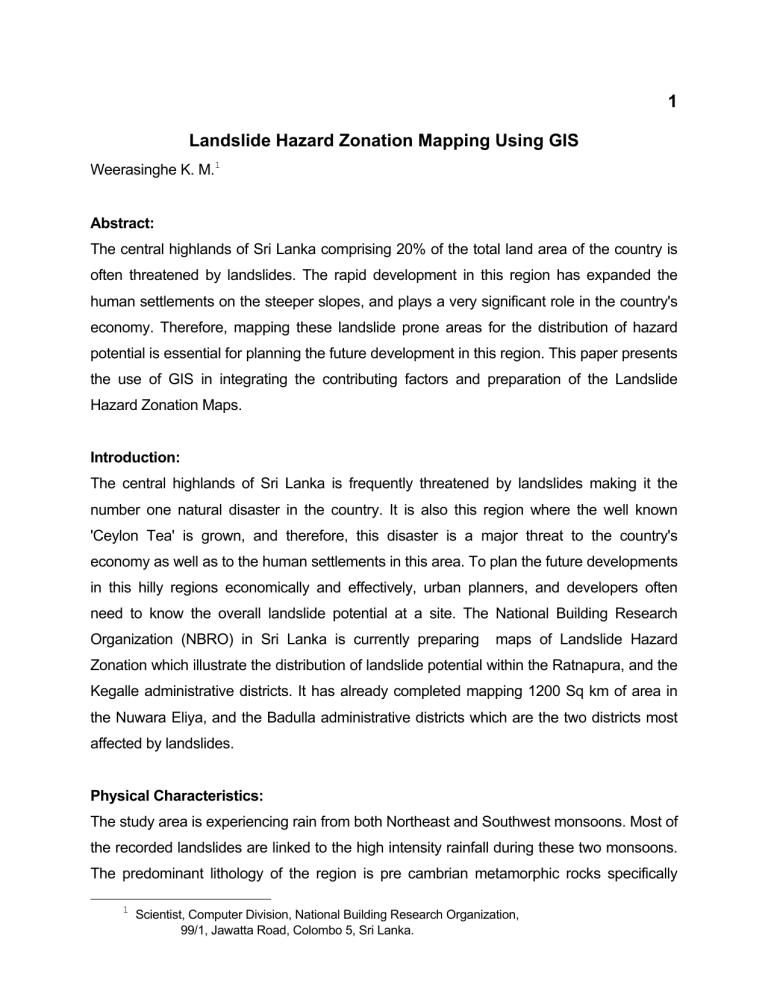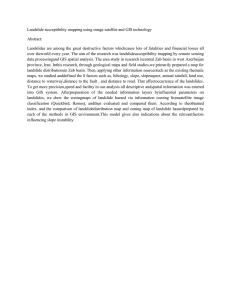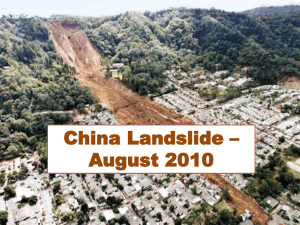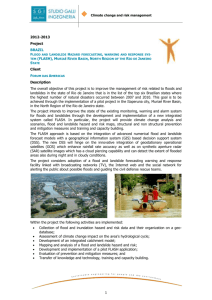
1 Landslide Hazard Zonation Mapping Using GIS Weerasinghe K. M.1 Abstract: The central highlands of Sri Lanka comprising 20% of the total land area of the country is often threatened by landslides. The rapid development in this region has expanded the human settlements on the steeper slopes, and plays a very significant role in the country's economy. Therefore, mapping these landslide prone areas for the distribution of hazard potential is essential for planning the future development in this region. This paper presents the use of GIS in integrating the contributing factors and preparation of the Landslide Hazard Zonation Maps. Introduction: The central highlands of Sri Lanka is frequently threatened by landslides making it the number one natural disaster in the country. It is also this region where the well known 'Ceylon Tea' is grown, and therefore, this disaster is a major threat to the country's economy as well as to the human settlements in this area. To plan the future developments in this hilly regions economically and effectively, urban planners, and developers often need to know the overall landslide potential at a site. The National Building Research Organization (NBRO) in Sri Lanka is currently preparing maps of Landslide Hazard Zonation which illustrate the distribution of landslide potential within the Ratnapura, and the Kegalle administrative districts. It has already completed mapping 1200 Sq km of area in the Nuwara Eliya, and the Badulla administrative districts which are the two districts most affected by landslides. Physical Characteristics: The study area is experiencing rain from both Northeast and Southwest monsoons. Most of the recorded landslides are linked to the high intensity rainfall during these two monsoons. The predominant lithology of the region is pre cambrian metamorphic rocks specifically 1 Scientist, Computer Division, National Building Research Organization, 99/1, Jawatta Road, Colombo 5, Sri Lanka. 2 charnockite and charnokeitic gneiss of the highland series. This area consists of a number of antiforms and synforms steeply dissected by fault systems of the regional plate techtonism. The terrain comprises mountains and valleys covered with vegetation and forest. Forty percent of the land in the central highlands of Sri Lanka is covered with estate managed tea and rubber. In addition to that, highly valued commercial crops such as potatoes, spices, and vegetables are increasingly grown by small holders. This area has considerably been expanded during the last three decades, because of the Accelerated Mahaweli Development Program which has created a rapid shift in the population and a development of new town centers and settlements (Arambepola et al, 1997). State of Nature Maps: Based on the physical characteristics and the professional judgement, the factors such as Land Use, Hydrology, Geology, Surface deposits, Slope Angle and Land Form are considered as the major causative factors of Sri lankan landslides. Therefore, the State of Nature (SON) maps of above factors were prepared at 1:10000 scale; each map representing a 8 km x 5 km area on the actual ground. The 1:10000 agricultural based topographic (ABMP) maps and the air photos issued by the Departments of Surveys in Sri Lanka were used as the basis. For preparing the SON maps, the information regarding the hydrological conditions, geological structure, surface deposits, landform, and past landslides were added to the ABMP maps with necessary field checks by a team of six geologists. Since the impact of causative factors on landslide potential varies, each of the above factors and the sub factors within a factor need to be relatively rated as shown in Table-1 (User Manual, 1995). Since the process required a repetitive overlaying of the landslide inventory map and the SON maps of above major factors, the use of GIS software PC ARC/INFO was immensely helpful in computing these relative ratings which were rooted on the relationship between the observed landslides and the various factor maps. Each of these SON map was then synthesized into a derived map based on the numerical 3 Sub Factors Sub Factor Elements and Relative Ratings Lithology Marble 0 Weathered Rock 1 Granite, Garnet, Biotite Gneiss 3 Charnockite, Granulite, or Bedrock not exposed 5 Quartzite 8 Dip & Scarp 70-90 0 Dip & Scarp 55-70 1 Dip 10-30, Scarp 45-55 2 Dip 0-10, Scarp 30-45 3 Dip 30-55, Scarp 0-30 4 25 - 120 0 10 - 25 or 120 - 155 2 155 - 180 4 0 - 10 6 Discontinuities Lineaments, Faults & Master Joints To be decided on case to case basis 0-2 Distribution of Soil Cover in meters Bare bedrock 0 Colluvium < 1 Overburden < 2 2 Colluvium 1-3 Overburden 2-8 8 Colluvium 3-8 Overburden > 8 9 Colluvium > 8 Overburden > 8 10 Slope Category 1 > 400 25 0 Major Factors Bedrock Geology and Geological Structure Amount and Direction of Dip in degrees Deviation Angle in degrees Surface Deposits Slope Angle Range Hydrology Slope Category 2 0 31 - 40 16 Slope Category 3 170 - 310 13 Slope Category 4 110 - 170 7 0 Slope Category 5 0 - 11 5 Relative Relief in meters > 350 1 4 0 - 170 2 170 - 350 5 0 - 0.07 or > 0.5 1 0.07 - 0.2 2 0.2 - 0.5 4 0.6 - 1 1 0.3 - 0.6 2 < 0.3 4 A > 5 or B > 10 1 3 < A < 5 or 6 < B < 10 2 A < 3 or B < 6 5 Proximity to water bodies To be decided on case to case basis 0-2 Land Use and Management Types Type 1 3 Type 2 8 Type 3 15 Type 1 1 Type 2 3 Type 3 5 Type 4 10 Basin Area in sq km Basin Shape (a unitless factor) Drainage Density in km / sq km (A) with Soil Cover (B) without Soil Cover Land Use Land Form Land Form Types 5 Table - 1 Relative Ratings for Major Factors and Sub Factors in terms of their Landslide Potential hazard ratings for each map unit as given in the table-1. For example, a derived map of geology represents the distribution of landslide potential based on only the geological structure the area. Data Capturing: The derived maps of slope, geological structure, and hydrology were digitized separately into polygon coverages using PC ARC/INFO version 3.4D. Because the available resources were limited, AutoCAD versions 11, and 12 were also used for digitizing the derived maps of Land Use, Land Form, and Surface Deposits which consist of relatively larger polygons. The maps digitized using AutoCAD were transformed into the PC ARC/INFO environment through DXF files. The numerical hazard ratings for each polygon were also fed into the polygon attribute tables. Maps showing past landslides, inaccessible slopes, and rivers were also digitized into separate polygon coverages. Small streams, major and secondary roads, railway lines were digitized into line coverages. Locations showing the town centers and villages were captured as a point coverage. Data Analysis and Landslide Hazard Zonation Maps: The digitized coverages of Geological Structure, Hydrology, Land Use, Land Form, Surface Deposits, and Slope were integrated to create an inferred map of landslide potential. For each polygon of this inferred map, the numerical hazard ratings for each factor were added to compute the overall hazard rating. The polygons of this inferred map is dissolved into different hazard zones using the criteria given in table-2. This criterion (User Manual, 1995) is arrived at by a number of trial and error in spatially matching the past landslides and inferred instability. The dissolved map of inferred landslide potential is overlaid by the coverages, Inaccessible Slopes, Past Landslides, and Rivers. The coverages, Small Streams, Major and Secondary roads, Railways, and Locations were also added to input as much as information possible. 6 Overall Hazard Rating (R) Hazard Zone R < = 40% 1 Safe slopes 40 < R < = 55 2 Landslides not likely to occur 55 < R < = 70 3 Modest level of landslide hazard 70 < R 4 Landslides are expected Table - 2 Description Criterion for Landslide Hazard Zonation Application of Landslide Hazard Zonation Maps: The main purpose of preparing the Landslide Hazard Zonation maps is to utilize them in future planning in this region. The maps identify the safe areas, and the areas which can be utilized with corrective measures. Therefore, by querying this spatial database with the budgetary allocations, and the user requirements the planners and developers can select the sites which are ideal for their intended purpose. Most importantly, an overlay of the Landslide Hazard Zonation map, and the Human Settlements and Infrastructure map can be used to identify the endangered human settlements for taking early actions to assure the safety of them. Similarly, these maps can be overlaid with a map of Land Use to identify the plantations which are threatened by potential landslides, and the plantations which need to be well managed to maintain the stability of the slopes. However, once the sites are selected with the guidance of these Landslide Hazard Zonation Maps, it is always advisable to carry out a location specific subsurface investigation to assess the risk on the intended purpose since these maps are based only on the surface data. Through number of awareness programs, the NBRO has reached the general public and the administration of the local governments in the affected area to make them aware of this spatial database, and to discuss how these maps can guide them for planning their future developments economically and effectively. In addition, the NBRO has suggested the Government of Sri Lanka to include a Landslide Mitigation Act in the land ordinance, so that, this act can be used as a policy for allocating the state land for various development Programs. 7 Conclusion: This paper demonstrate the use of GIS in identifying the distribution of landslide potential in the central highlands of Sri Lanka. Considering the physical characteristics of the affected region, hydrological conditions, geological structure, land use, land form, slope angle range, and distribution of surface deposits are considered as the major causative factors of landslides. For the landslide hazard zonation mapping at the NBRO, the individual landslide potential of above factors are spatially integrated; based on this cumulative hazard potential, different hazard zones are allocated to the threatened area. These Landslide Hazard Zonation Maps play a major role in the identification of human settlements and plantations which are threatened by potential landslides, so that, the Local Governments and the Department of Social Services can take an early action to assure the safety of them. The NBRO has reached the general public and the administration of the Local Governments to educate them of the importance of using this spatial data base in planning the future developments in the mountainous region in Sri Lanka. Acknowledgement: The author would like to thank Mr. C Tissera, the Director General of the NBRO, Dr. R. K. Bhandari, the former Chief Technical Advisor for the Landslide Hazard Mapping Project (LHMP) at the NBRO, and Mr. N.M.S.I Arambepola, the Team Leader of the LHMP, for their valuable guidance and encouragement. She acknowledges with gratitude the support given by the GIS expert Dr. Prasantha Jayawardhane during his short course in PC ARC/INFO. She also acknowledges the encouragement of Mr. Champake Mendis, the Head of the Computer Division, and Mr. M.P.K. Perera, the former Head of the Computer Division. She highly appreciates the support given by Miss Dharshika Perera, Miss Neelakshi Silva, and Mr. D.M.L. Bandara who made this computer aided mapping a reality. References: 8 Arambepola, N.M.S.I., Bandara, R.M.S., Pallewela, P.P.D.H. (1997), Landslide Hazard Zonation Mapping and Geoenvironmental Problems Associated with the Occurrence of Landslides, Proceedings of the CBRI Golden Jubilee Conference. Bhandari, R.K., Perera, M.P.K., Weerasinghe, K.M. (1996), Application of GIS in Landslide Hazard Mapping at the NBRO, Proceedings of the First GIS User Group Conference. User Manual (1995), Landslide Hazard Mapping in Sri Lanka, Landslide Hazard Mapping Project SRL89/001. Computer Division 3rd November, 1997 Mr. K.M. Jagadeesh Head - Consultancy and Professional Services 8, Balaji Estate, Sudarshan Munjal Marg, Kalkaji New Delhi - 110 019 India Second Indian Annual ESRI/ERDAS '97 User Conference Presenting A Paper Dear Sir This is with refernce to the Abstract of the paper, Landslide Hazard Zonation Mapping using GIS, submitted by me on 24th October, 1997. I thank you again for inviting for the above conference and am forwarding herewith the complete paper, Landslide Hazard Zonation Mapping using GIS, for your consideration for the above conference. If my paper is accepted for presentation only, I will be attending the conference, and therefore, the registration fee is not enclosed. However, The completed form of registration is enclosed. Thank You Yours truly, Kumari M. Weerasinghe Scientist




